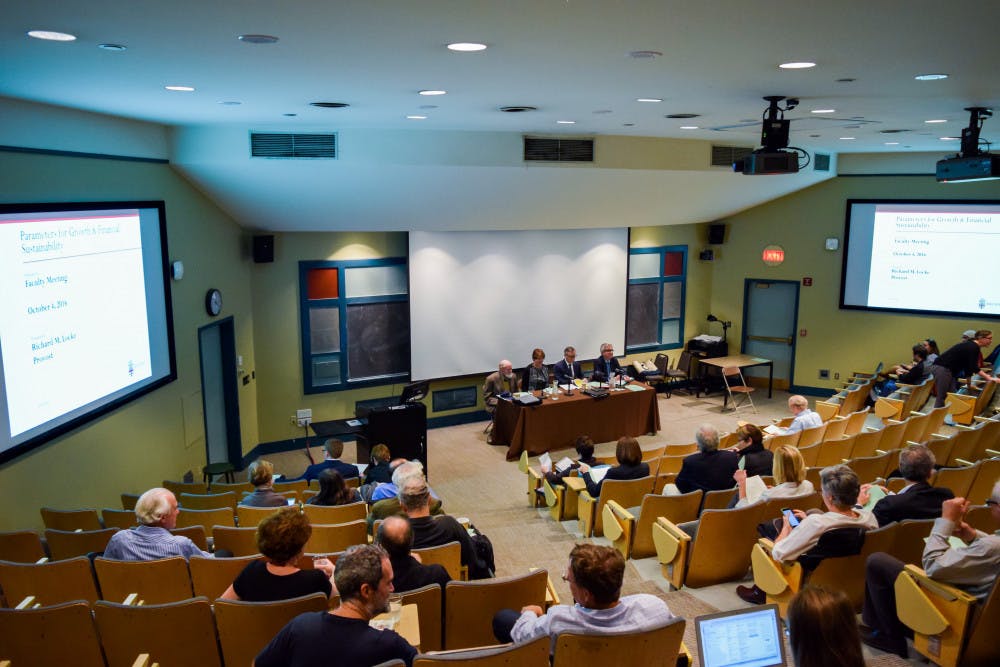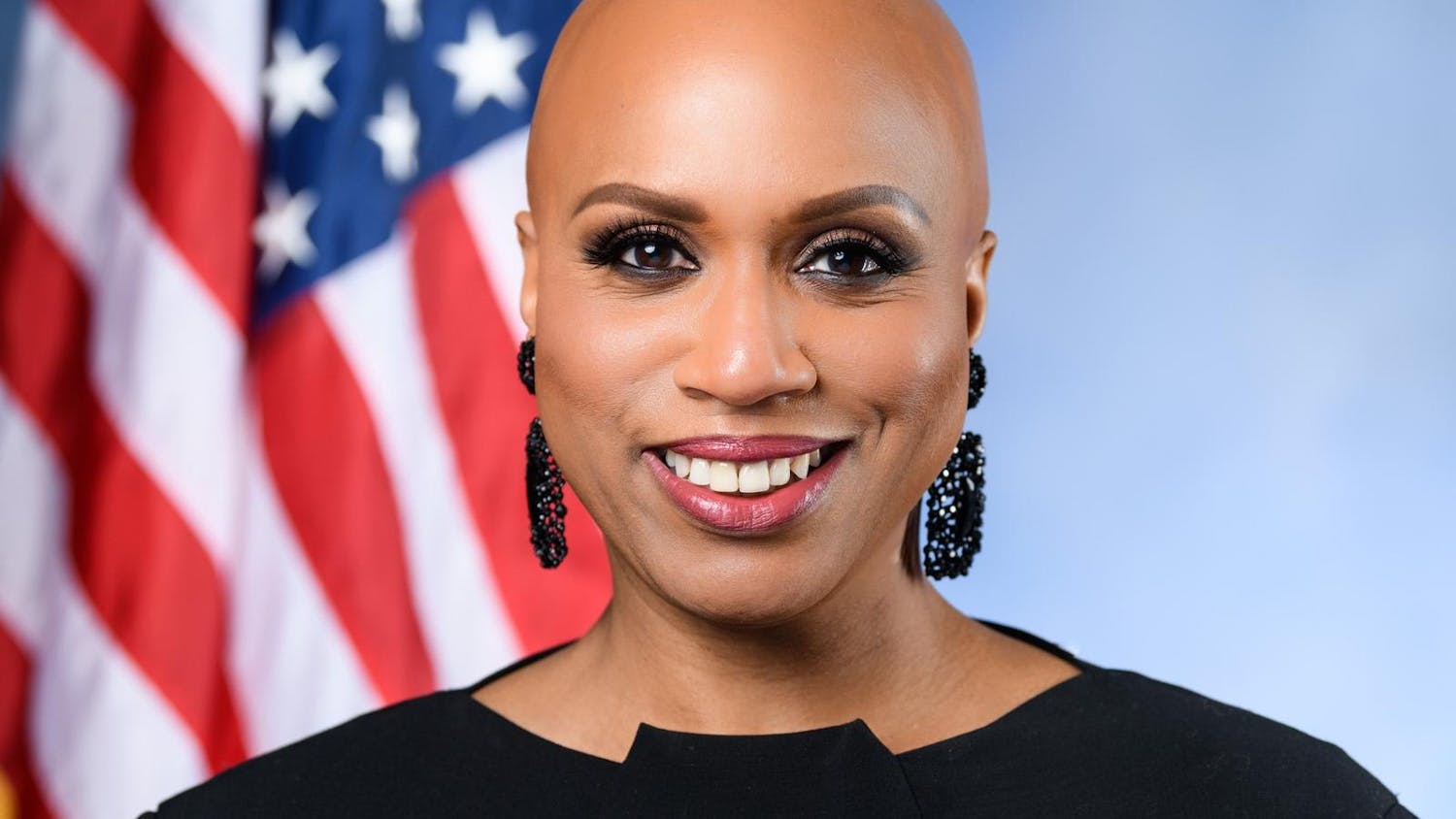Updated Oct. 5 at 9:56 a.m.
Provost Richard Locke P’17 announced historic changes to the University’s budget and business model at the faculty meeting Tuesday in Salomon 001. The plan outlined a significant shift in the structure of the University, freezing undergraduate admission and growing the University’s graduate programs. This change will require that the University invest further in lab facilities and basic infrastructure while cutting costs to accommodate shifting revenues. Due to the brevity of the faculty meeting, little discussion by faculty members followed Locke’s financial presentation.
The new financial model is the result of over a year of work, with involvement from the Office of the Dean of the College, the Office of College Admission, the Office of Financial Aid and the Investment Office, Locke said.
Locke also noted that it is “highly unusual to share this kind of information (with) the community.”
“In the same way that we are being extremely transparent about diversity and inclusion, … we’re trying to be incredibly transparent and engage the community,” Locke added.
Graduate emphasis
This new budget plan comes in light of the financial pressure the University has experienced in past decades. While the undergraduate population has grown drastically, past financial models overestimated the growth of the endowment and underestimated costs such as those associated with refurbishing facilities, Locke said. The combination of these two trends has resulted in stress points, such as lack of undergraduate housing, insufficient academic support systems and out-of-date infrastructure, he added. Additionally, the University relies more heavily on tuition and fees more than its peers, Locke said.
Subsequently, the University will freeze undergraduate admission at 1,650 admitted students each year — a departure from the trend of growth since the 1960s and 70s. When accounting for transfer students, Rhode Island School of Design students and Resumed Undergraduate Education students, the undergraduate student body will be solidified at 6,848 students, he added.
The decision is partly informed by the fact that the University now has a larger undergraduate enrollment than its peers, including Dartmouth, Yale and the Massachusetts Institute of Technology, while offering fewer research operations and professional schools, Locke said.
Rather than growing the undergraduate population, the University plans to “grow graduate student programs in a targeted and incremental way," Locke said.
According to the University’s fall 2015 census, Brown serves about 2,200 graduate students in total.
By transitioning growth to the graduate schools, the University hopes to further its emergence as an international research university.
In order to accommodate this growth in the graduate schools, the University has allocated new funding to support research, invest in core facilities and draw graduate researchers, Locke said. This will allow the University to contend with its peers, he added.
The University has also put aside more money for infrastructure upkeep and updates, as well as technology such as wireless internet that must be continuously upgraded, Locke said.
Another added expense is the new engineering building that will be completed in January 2018. The University must budget for its heat, electricity, staff and maintenance, which adds several million dollars into the expense budget, Locke added.
‘Tightening the belt’
While the University aims to make strategic investments in certain parts of campus, others will see smaller budgets. Continuing the work of the Deficit Reduction Working Group, the University will cut costs by using more integrated construction practices for new buildings and renovations, using more strategic office supply sourcing and temporarily slowing the rate of faculty growth, Locke said.
The University will also propose an admission and financial aid plan to the University Resources Committee to transition some of the financial aid budget to serve “a broader spectrum of students,” especially those from middle-class families, Locke said. Under the existing financial aid policy, the University loses many middle-class students to peer universities that offer more competitive financial aid packages, Locke said.
By focusing financial aid on these students, the University can align the growth of the financial aid budget with the growth of tuition and fees while remaining need-blind, maintaining the same number of students on financial aid and becoming “attractive to all families, whether needy, wealthy or middle class,” Locke said.
“We think that if we do these things — spend a couple years tightening the belt — that we’ll be able to balance us and make us sustainable,” Locke said.
Shifting revenue streams
The budget plan also aims to change the balance of the University’s revenue streams. While the University has typically withdrawn about 5 percent of the endowment on an annual basis, Locke said the University will only withdraw 4.5 percent going forward “to protect the long-term health of the University.”
Due to the turbulence of current markets, universities have received returns lower than projected. In fact, this year most Ivy League universities showed negative returns on their endowments, and Brown saw a -1.1 percent return. Though the University typically budgets for a 7.5 percent return, markets have been churning out less than a 6 percent return rate, Locke said.
Locke also said the University anticipates that the $3 billion BrownTogether capital campaign will increase the size of the endowment to compensate for the smaller percentage payouts, as the campaign has already reached over $1.2 billion.
While the current endowment is only $3.2 billion — a fraction of the size of peer universities’ — BrownTogether aims to increase its value to $5 billion, he added. This could allow for a larger proportion of the University’s annual budget to be supported by endowment withdrawals, meaning that the University will rely less on tuition and fees, he added.
Locke also said the University plans to propose another admission and financial aid motion to the URC to raise the cost of tuition and fees by 5 percent one year — rather than the typical annual increase of 4 percent.
“This would give us a shot of cash when we need it,” Locke added. “But it’s something we still have to talk about.”
The University also projects growth for the annual fund, which is used directly to help pay operating expenses. This year, the annual fund raised $36 million, and the next several years it expects to raise $50 million each year, Locke said.
Managing the deficit
The financial shortage caused by these shifts in revenues and costs will “be a bucket of cold water,” Locke said, adding, “We can handle it.”
With this collective loss of revenue and projected increase in costs, University models show the expected deficit peaking at $32 million before beginning to decrease, Locke said.
“The deficit will actually be greater than we thought, but we think we have levers available to us — some that we can already exercise and others that we have to get permission and engage with the community to do,” Locke said.
Keeping in mind the planned cost-cutting and revenue increases, the University aims to lower the potential $32 million peak deficit to $7 million, with an end goal of a $1 million deficit, Locke said. “But a million-dollar deficit in the scheme of a billion-dollar budget is balanced,” he added.





